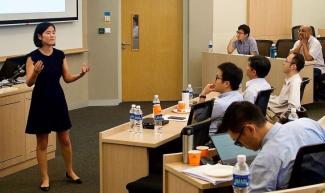
Is foreign institutional investment good or bad for a firm? It depends on whose point of view you take, says SMU Assistant Professor Lou Yun.
By Sim Shuzhen
SMU Office of Research & Tech Transfer – In the television series The Walking Dead, a fast-spreading, hitherto-unknown virus has turned the majority of the world’s human population into walking corpses, hungry for flesh. Amid the zombie apocalypse, the carefully constructed order of society has collapsed, leaving small bands of survivors to fend for themselves.
Out of this chaos emerges a new leader – the brutish Negan, whose followers, known as the Saviours, enslave other survivor communities and extort tributes from them.
“He and his followers claim that they are the Saviours – they think they are maintaining the long-term order of society. But from the point of view of the people, they are in fact the villains,” said Assistant Professor Lou Yun of the Singapore Management University (SMU) School of Accounting, speaking on 14 April 2018 at the Tri-University Accounting Research Conference. The event, held at the National University of Singapore (NUS), provided researchers from SMU, NUS and Nanyang Technological University with the opportunity to present and gain feedback on their research.
If you thought zombies and accounting would never be mentioned in the same sentence, think again. Professor Lou used the television show to segue into the paper she was presenting, titled ‘Savior or Villain? The Debt-market Effects of Foreign Institutional Ownership’. Co-authored with Associate Professor Li Xi of the London School of Economics and Political Science, the study examines how debtholders (lenders like banks) perceive and respond to foreign institutional investors who buy equity in firms.
Don’t forget the lenders
In the existing literature, foreign institutional ownership is generally regarded as positive for firms and shareholders, said Professor Lou. Evidence suggests that foreign institutional investors can increase firm value and financial performance, improve corporate governance, promote long-term investment in tangible, intangible and human capital, and foster innovation in local firms. “From this point of view, everything is positive. Foreign institutional investors are the saviours – they bring good to local communities and generate long-term benefits,” said Professor Lou.
But this rosy outlook neglects the perspectives of other stakeholders, such as debtholders that extend credit to firms, added Professor Lou.
For their part, debtholders may also view foreign institutional investors as saviours, since prior research suggests that such investors tend to push through measures that ensure good corporate governance, said Professor Lou. “From that point of view, debtholders could free-ride on the monitoring efforts of foreign institutions.” If so, debtholders may see firms with foreign institutional ownership as presenting a lower credit risk, and thus extend more lenient debt contracting terms to them, she added.
On the other hand, the interests of debtholders and shareholders are often not aligned – certain actions taken by shareholders, such as making a risky investment, are unlikely to go over well with debtholders. “We argue that these kinds of conflicts can be aggravated when the institutional investors are foreign,” said Professor Lou.
One reason for this is that foreign institutional investors tend to have weaker business and social ties with the local community, and hence may be more willing to push very aggressive policies with short-term horizons. “Often, foreign capital is associated with ‘hot’ money. [The perception is that foreign investors] get in and get out quickly, and don’t care what happens to the firm in the future,” Professor Lou explained.
In this picture, where foreign institutional investors are regarded as the villains – “irresponsible locust swarms” that “suck off substance and let companies die once they have eaten them away”, to quote German politician Franz Müntefering – debtholders would be more likely to impose more restrictive debt contracts, said Professor Lou.
Outsmarting the opportunists
To determine which of these two scenarios plays out in real life, Professor Lou and Professor Li analysed a comprehensive dataset of equity portfolio holdings by US institutions in non-US companies. They chose to focus on US institutional investors as this group has the strongest presence in global capital markets, is known to push for good corporate governance, and at the same time is not bound by US law to maximise the interests of other stakeholders, said Professor Lou.
The researchers found that non-US companies with higher US institutional ownership indeed face more restrictive debt contract terms. In particular, syndicated loans and public bonds offered to such companies come attached with more general covenants, which protect debtholders by restricting business operations such as asset sales, mergers and acquisitions, investments and dividend payouts, said Professor Lou. This association was even more pronounced when the US institutional investors had short investment horizons, she added.
Surprisingly, higher US institutional ownership did not change the price of the syndicated loans or public bonds, and also did not affect debtholders’ use of financial covenants (those that place limits on balance sheet items and financial ratios, for example). This suggests that debtholders are less worried about US institutional investors posing a credit risk; instead, they perceive these investors as potentially expropriating (taking control of) wealth through opportunistic actions, said Professor Lou.
“Essentially, lenders are using the restrictive terms of covenants as a way to protect themselves against potential expropriative behaviour of US institutional investors,” Professor Lou said in an interview after the talk, adding that the researchers plan to submit the paper to a top finance journal after further revisions.
“We wanted to entertain the possibility that maybe foreign institutional investors are not all good,” she explained. “We’re not saying that they’re bad, but we want a more complete picture from the point of view of different participants.”
Back to Research@SMU Issue 55
Image credit: Sim Shuzhen